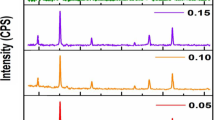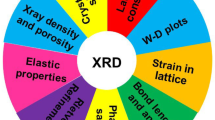Abstract
The role of effective anisotropy in nanocrystalline ferromagnets is investigated. These alloys are prepared by annealing amorphous ribbons and have excellent soft magnetic properties. A two-phase model is established considering the role of the intergranular amorphous phase. The results indicate a strong dependence of effective anisotropy on the structure and magnetic parameters of the amorphous phase as well as on the size of a grains. In view of the new model, the magnetic hardening beyond the optimally annealing temperature seems to be ascribed to the deterioration in magnetic properties of interfacial amorphous phase.
Similar content being viewed by others
References
Yoshizawa, Y., Oguma, S., Yamamoto, T., New Fe-based soft magnetic alloys composed of ultrafine grain structure,J. Appl. Phys., 1988, 64: 6044.
Suzuki, K., Makino, N., Kataoka, N.et a1., Hgh saturation magnetization and soft magnetic properties of bcc Fe-Zr-B alloys with ultrafine grain structure,Mater. Trans. JIM, 1990, 31: 743.
Fujii, Y., Fujita, H., Seki, A.etal., Magnetic properties of fie crystalline Fe-P-CCu-X alloys,J. Appl. Phys., 1991, 70: 6241.
Herzer, G., Grain size dependence of coercivity and permeability in nanocrystalline ferromagnets,IEEE Trans. Magn., 1989, 25: 3327.
Sawa, T., Yakaashi, Y., Magnetic properties of FeCu(3d transition metal) SiB alloys composed of ultrafine grain structure,J. Appl. Phys., 1990, 67: 5565.
He Kai-Yuan, Bai KuiChang, Zhi Jinget al., An exploration of the superior properties in soft nanocrystalline Fe-Cu-Nb-Si-B, inProc. Magnetic Nanometered Materials and Physics (in Chinese), Beijing: Institute of Physics, 1993, 1–2.
Zhang Jiaji, Tu Guochao, Li Dianyinget al., An investigation of high initial permeability in nanocrystalline FeCuSiB, inProc. Magnetic Nanometered Materials and Physics (in Chinese), Beijing: Institute of Physics, 1993, 3–4.
Harris, H., Plischke, M., Zuckermann, M, J., New model for amorphous magnetism,Phys. Rev. Lett., 1973, 31: 160.
Alben, R., Becker, J.J., Chi, M.C., Random anisotropy in amorphous alloys,J. Appl. Phys., 1978, 49: 1653.
Ma Ruzhang,Mössbauer Spectroscopy (in Chinese), Beijing: Institute of Iron and Steel Beijing, 1984, 126–127.
Liu, T., Xu, Z.X., Ma, R.Z.et al., An investigation of structure and magnetic properties of nanocrystalline Fe73.5-Cu1Mo3Si13.5B9 alloy,Acta Physica Sinica (in Chinese). 1996, 45: 528.
Reininger, T., Hofmann, B., Kronmuller, H., Magnetization processes in nanocrystalline ferromagnets,J. Magn. Magn. Mater., 1994, 111: L220.
Author information
Authors and Affiliations
Additional information
Project supported by the Special Item Foundation for Doctor of Advanced College, the Chinese Academy of Sciences and Beijing Synchrotron Radiation Facility. National Laboratory.
Rights and permissions
About this article
Cite this article
Liu, T., Xu, Z., Zhao, Z. et al. Structure and magnetic properties of nanocrystalline ferromagnets (I). Sci. China Ser. A-Math. 40, 297–302 (1997). https://doi.org/10.1007/BF02874523
Received:
Issue Date:
DOI: https://doi.org/10.1007/BF02874523




